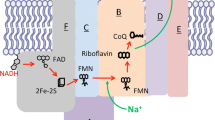Abstract
The marine bacteriumVibrio alginolyticus was found to possess the respiratory Na+ pump that generates an electrochemical potential of Na+, which plays a central role in bioenergetics ofV. alginolyticus, as a direct result of respiration. Mutants defective in the Na+ pump revealed that one of the two kinds of NADH: quinone oxidoreductase requires Na+ for activity and functions as the Na+ pump. The Na+ pump composed of three subunits was purified and reconstituted into liposomes. Generation of membrane potential by the reconstituted proteoliposomes required Na+. The respiratory Na+ pump coupled to the NADH: quinone oxidoreductase was found in wide varieties of Gramnegative marine bacteria belonging to the generaAlcaligenes, Alteromonas, andVibrio, and showed a striking similarity in the mode of electron transfer and enzymic properties. Na+ extrusion seemed to be coupled to a dismutation reaction, which leads to the formation of quinol and quinone from semi-quinone radical.
Similar content being viewed by others
References
Asano, M., Hayashi, M., Unemoto, T., and Tokuda, H. (1985).Agric. Biol. Chem. 49, 2813–2817.
Booth, I. R. (1985).Microbiol. Rev. 49, 359–378.
Chernyak, B. K., Dibrov, P. A., Glagolev, A. N., Sherman, M. Yu., and Skulachev, V. P. (1983).FEBS Lett. 164, 38–42.
Dimroth, P. (1980).FEBS Lett. 122, 234–236.
Dimroth, P. (1987).Microbiol. Rev. 51, 320–340.
Hayashi, M., and Unemoto, T. (1986).FEBS Lett. 202, 327–330.
Kakinuma, Y., and Unemoto, T. (1985).J. Bacteriol. 163, 1293–1295.
Ken-Dror, S., Preger, R., and Avi-Dor, Y. (1986a).Arch. Biochem. Biophys. 244, 122–127.
Ken-Dror, S., Lanyi, J. K., Schobert, B., Silver, B., and Avi-Dor, Y. (1986b).Arch. Biochem. Biophys. 244, 766–772.
Krulwich, T. A. (1986).J. Membr. Biol. 89, 113–125.
Lanyi, J. K. (1979).Biochim. Biophys. Acta 559, 377–397.
Matsushita, K., Ohnishi, T., and Kaback, H. R. (1987).Biochemistry 26, 7732–7737.
Mitchell, P. (1961).Nature (London) 191, 144–148.
Mitchell, P. (1973).J. Bioenerg. 4, 63–91.
Nakamura, T., Tokuda, H., and Unemoto, T. (1982).Biochim. Biophys. Acta 692, 389–396.
Nakamura, T., Tokuda, H., and Unemoto, T. (1984).Biochim. Biophys. Acta 776, 330–336.
Padan, E., Zilberstein, D., and Schuldiner, S. (1981).Biochim. Biophys. Acta 650, 151–166.
Plack, R. H., Jr., and Rosen, B. P. (1980).J. Biol. Chem. 255, 3824–3825.
Schuldiner, S., and Fishkes, H. (1978).Biochemistry 17, 706–711.
Sprott, G. D., Drozdowski, J. P., Martin, E. L., and MacLeod, R. A. (1975).Can. J. Microbiol. 21, 43–50.
Tokuda, H. (1983).Biochem. Biophys. Res. Commun. 114, 113–118.
Tokuda, H. (1984).FEBS Lett. 176, 125–128.
Tokuda, H., and Kaback, H. R. (1977).Biochemistry 16, 2130–2136.
Tokuda, H., and Unemoto, T. (1981).Biochem. Biophys. Res. Commun. 102, 265–271.
Tokuda, H., and Unemoto, T. (1982).J. Biol. Chem. 257, 10007–10014.
Tokuda, H., and Unemoto, T. (1983).J. Bacteriol. 156, 636–643.
Tokuda, H., and Unemoto, T. (1984).J. Biol. Chem. 259, 7785–7790.
Tokuda, H., and Kogure, K. (1989).J. Gen. Microbiol. 135, 703–709.
Tokuda, H., Nakamura, T., and Unemoto, T. (1981).Biochemistry 20, 4198–4203.
Tokuda, H., Sugasawa, M., and Unemoto, T. (1982).J. Biol. Chem. 257, 788–794.
Tokuda, H., Udagawa, T., and Unemoto, T. (1985).FEBS Lett. 183, 95–98.
Tokuda, H., Udagawa, T., Asano, M., Yamamoto, T., and Unemoto, T. (1987).FEBS Lett. 215, 335–338.
Tokuda, H., Asano, M., Shimamura, Y., Unemoto, T., Sugiyama, S., and Imae, Y. (1988).J. Biochem. 103, 650–655.
Tsuchiya, T., and Shinoda, S. (1985).J. Bacteriol. 162, 794–798.
Tsuchiya, T., Raven, J., and Wilson, T. H. (1977).Biochem. Biophys. Res. Commun. 76, 26–31.
Udagawa, T., Unemoto, T., and Tokuda, H. (1986).J. Biol. Chem. 261, 2616–2622.
Unemoto, T., Hayashi, M., and Hayashi, M. (1977).J. Biochem. 82, 1389–1395.
Author information
Authors and Affiliations
Rights and permissions
About this article
Cite this article
Tokuda, H. Respiratory Na+ pump and Na+-dependent energetics inVibrio alginolyticus . J Bioenerg Biomembr 21, 693–704 (1989). https://doi.org/10.1007/BF00762687
Received:
Issue Date:
DOI: https://doi.org/10.1007/BF00762687




